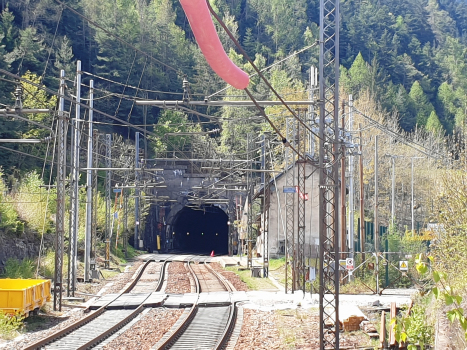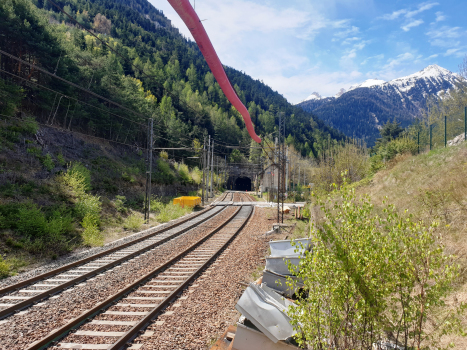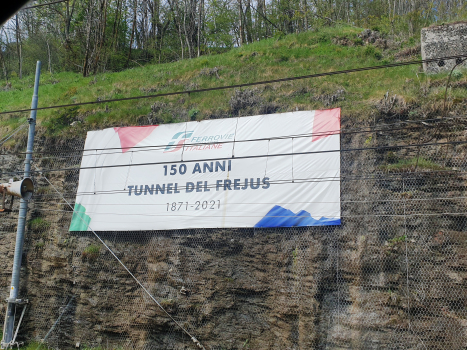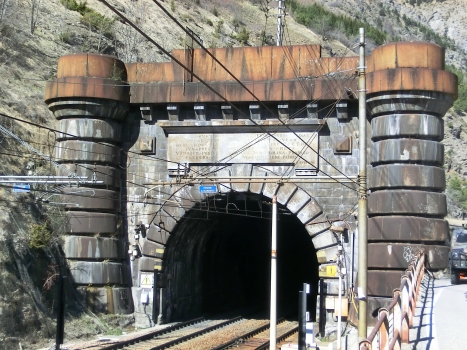General Information
| Name in local language: | Tunnel du Mont-Cenis / Traforo del Moncenisio; Traforo ferroviario del Frejus / Tunnel ferroviaire du Fréjus |
|---|---|
| Other name(s): | Fréjus Rail Tunnel |
| Beginning of works: | 1857 |
| Completion: | 17 September 1871 |
| Status: | in use |
Project Type
| Structure: |
Tunnel |
|---|---|
| Function / usage: |
Railroad (railway) tunnel |
| Construction method: |
Manual excavation |
Location
| Location: |
Modane, Savoie (73), Auvergne-Rhône-Alpes, France Bardonecchia, Torino, Piedmont, Italy |
|---|---|
| Through: |
|
| Part of: | |
| Coordinates: | 45° 11' 39.82" N 6° 40' 7.65" E |
| Coordinates: | 45° 4' 53.59" N 6° 42' 33.33" E |
Technical Information
Dimensions
| number of tracks | 2 | |
| depth | max. 1 600 m | |
| number of tubes | 1 | |
| Initial construction | ||
|---|---|---|
| tunnel length | 12 819.6 m | |
| Extension | ||
| tunnel length | 13 658 m | |
Cost
| cost of construction | French Franc 75 000 000 |
Annual Tunneling Progress
| Year | From Bardonnèchia | From Modane |
|---|---|---|
| 1858 | 285 m* | 213 m* |
| 1859 | 236 m* | 133 m* |
| 1860 | 204 m* | 139 m* |
| 1861 | 270 m | 193 m* |
| 1862 | 380 m | 243 m* |
| 1863 | 426 m | 376 m |
| 1864 | 621 m | 467 m |
| 1865 | 765 m | 458 m |
| 1866 | 813 m | 212 m |
| 1867 | 825 m | 688 m |
| 1868 | 639 m | 681 m |
| 1869 | 827 m | 604 m |
| 1870 | 889 m | 746 m |
| Total | 7 080 m | 5 153 m |
| * manual excavation | ||
Tunneling became more effective than purely manual excavation a few years into the project due to the invention of the jackhammer by Thomas Bartlett in 1855 which was improved upon by Sommeillier. They were powered by compressed air due to another invention by Daniel Colladon, a Swiss physicist. These inventions allowed the originally planned drilling time of 24 years to be reduced to 13.
Excerpt from Wikipedia
The Fréjus Rail Tunnel (also called Mont Cenis Tunnel) is a rail tunnel of 13.7 km (8.5 mi) length in the European Alps, carrying the Turin–Modane railway through Mont Cenis to an end-on connection with the Culoz–Modane railway and linking Bardonecchia in Italy to Modane in France. Its mean altitude is 1,123 m and it passes beneath the Pointe du Fréjus (2,932 m) and the Col du Fréjus (2,542 m).
The Fréjus tunnel remains an important link in the connection between Rome and Paris, via Turin and Chambéry. Following the development of car and truck transportation, the Fréjus Road Tunnel was built along the same path from 1974 to 1980. A future high-speed rail tunnel to improve transit capacity between France and Italy, called the Mont d'Ambin Base Tunnel, is being planned as part of the Turin–Lyon high-speed railway project.
Construction
The initial gallery was 12.8 kilometres long, twice as much as the previously longest tunnel. Drilling started in August 1857 from Bardonecchia and in December 1857 from Modane. At construction start, both ends were in Piedmont-Sardinia, but this changed with the transfer of Savoy to France in 1860 (Treaty of Turin). On 26 December 1870, French and Italian workers shook hands as the two teams met halfway: the galleries were aligned to about 40 cm horizontally and 60 cm vertically. The tunnel opened for traffic on 17 September 1871, thus making it the oldest of the large tunnels through the Alps. The gallery was extended to its present length in 1881 with a new reinforced entrance in more stable ground on the French side.
The construction, directed by Germain Sommeiller, was scheduled to take 25 years, but was completed in only 14 years thanks to technical innovations such as pneumatic drilling machines and electrical ignition of explosive charges. In the final construction years, the use of recently invented dynamite further accelerated the tunnel's completion. The next two Alpine tunnels were built with similar techniques: The Gotthard Tunnel opened in 1882 and the Simplon Tunnel in 1906.
The tunnel was enlarged in 2010 to allow transport of container trucks on piggy-back wagons, as part of the Autoroute Ferroviaire Alpine.
From 1868 to 1871, the Mont Cenis Pass Railway worked as a temporary link over the Mont Cenis Pass. It was closed soon after the Fréjus Railway opened.
Fortifications
Once Savoy became part of France, the Fréjus Tunnel became a possible invasion route from Italy to France, avoiding the difficulties of the Mont Cenis pass. Accordingly, an extraordinary amount of fortification was placed around Modane. The Fort du Replaton and the Fort du Sapey were built in the late 19th century on the heights across the valley of the Arc. In the 1930s the Maginot Line fortifications Ouvrage Saint-Gobain, Ouvrage Saint-Antoine and additional fortifications at Le Sappey were built.
A blockhouse along the rail line to the east of the modern tunnel entrance has become a tourist attraction. The maison penchée ("leaning house") was built in 1939 to guard the tunnel entrance over an ammunition magazine connected to the tunnel by a gallery. In 1944 the retreating Germans exploded two rail wagons inside the tunnel entrance, causing the magazine to explode and blasting the blockhouse off its foundations, landing on a tilt.
Monumental entry
The original monumental entry on the French side of the tunnel at Modane is now a minor tourist attraction, having been bypassed in 1881 in favor of a new entrance somewhat to the east in more stable ground. A steam locomotive has been placed in the old entrance, which is now located along a roadside.
Text imported from Wikipedia article "Fréjus Rail Tunnel" and modified on July 23, 2019 according to the CC-BY-SA 4.0 International license.
Participants
- Severinio Grattoni (engineer)
- Sebastiano Grandis (engineer)
- Camille Ferroux (engineer)
- Germain Sommeiller (director general of works)
Relevant Web Sites
Relevant Publications
- (1864): The Actual State of the Works on the Mont Cenis Tunnel, and Description of the Machinery Employed. In: Minutes of the Proceedings of the Institution of Civil Engineers, v. 23, n. 1864 ( 1864), pp. 258-286, plates.
- The Air Compressors at the Mont Cenis Tunnel. In: Scientific American, v. 26, n. 5 (27 January 1872), pp. 63-64.
- (2005): Consolidation and excavation works for the upgrading of the Frejus railway tunnel. Presented at: AFTES - Journées techniques, Chambéry, 2005, pp. 543-550.
- Facts and Figures about the Mont Cenis Tunnel. In: Scientific American, v. 24, n. 4 (21 January 1871), pp. 55.
- (1890): Les grandes entreprises modernes. Alfred Mame et Fils, éditeurs, Tours (France), pp. 107-144.
- About this
data sheet - Structure-ID
20004586 - Published on:
21/08/2002 - Last updated on:
20/05/2024














